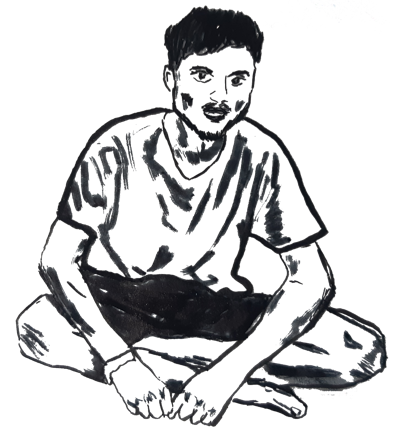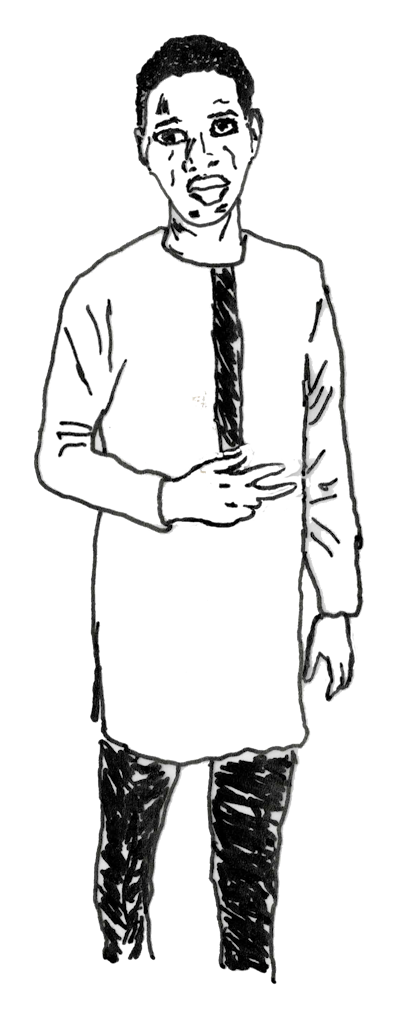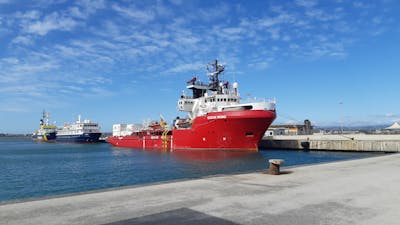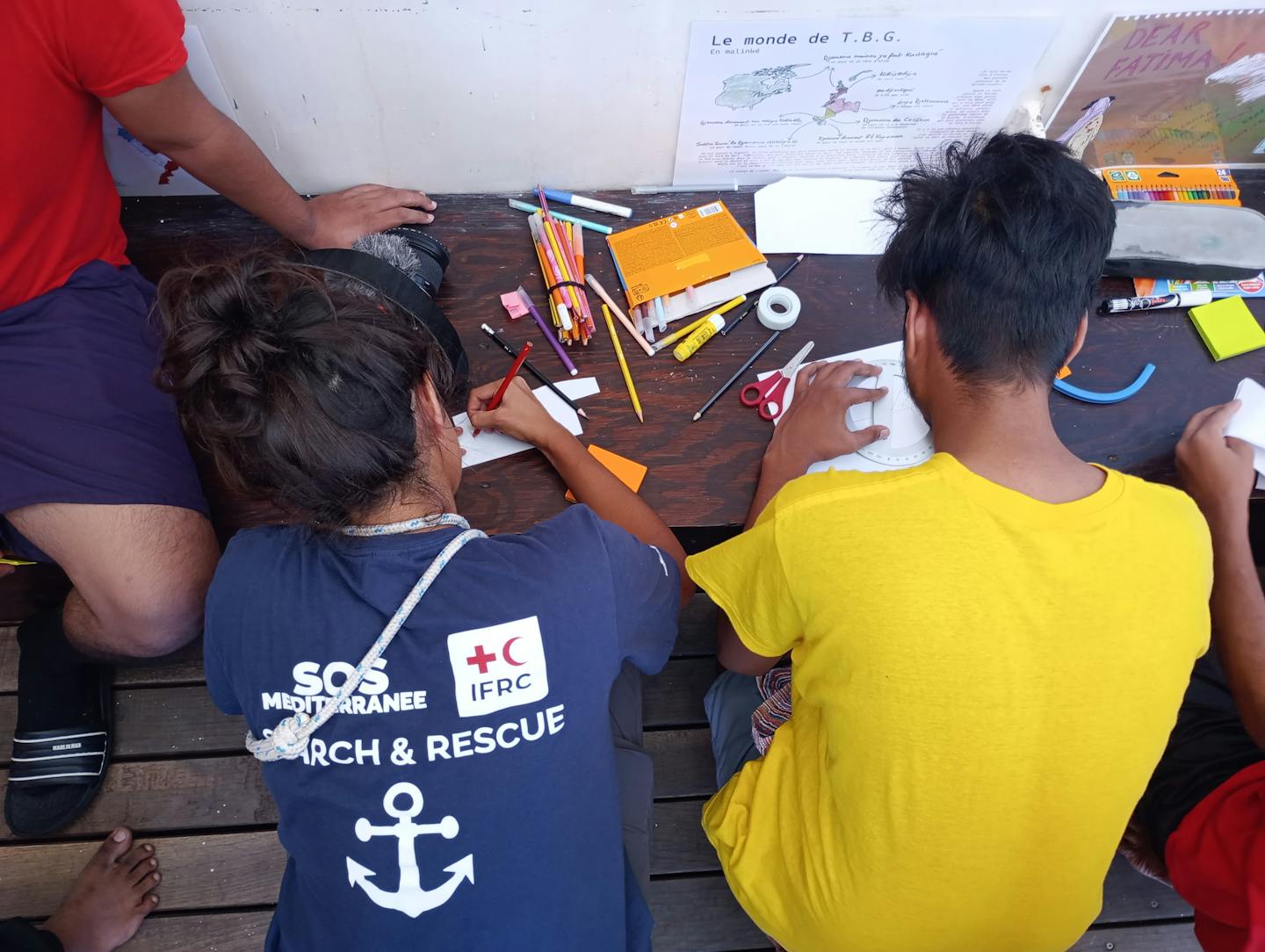This series of articles draws on a year of research conducted on board the Ocean Viking, the civilian search-and-rescue ship operated in the central Mediterranean by the NGO SOS Méditerranée. It explores the perspectives of exiled people based on testimonies from 110 survivors who were picked up while attempting the crossing from North Africa, as well as crew members’ experiences and the researcher’s creative collaborations while onboard the ship.
This is the first of a four-part series. Read part two here, and explore an immersive French-language version of the series here.
‘The journey we’ve undertaken’
“We were ready to jump. We were so afraid the Libyans would arrive!” These words came from a young Syrian man, recorded in the data table as part of my year-long study aboard the Ocean Viking search-and-rescue ship, between the summers of 2023 and 2024.
His words did not reflect an isolated incident. Among the 110 rescued people who took part in the onboard survey, nearly a third described a similar fear at the sight of a ship on the horizon. Not fear of imminent shipwreck or drowning, but of being intercepted by Libyan forces and returned to that country.

The words echo those of Shakir, a Bangladeshi man I met on the OV – as the Ocean Viking ship is commonly nicknamed. He told me: “You refreshed our minds with the workshops. Since Libya and the sea, we felt lost. Now, we understand the journey that we’ve undertaken.”
On the OV’s deck and in the containers serving as shelters until disembarkation in Italy, I offered participatory mapping workshops. Around 60 people took part, retracing the steps, places and timelines of their journeys through hand-drawn maps.
I developed this collaborative research method to encourage the expression of knowledge formed through migration. I had not anticipated that these gestures and drawings could also help reclaim points of reference and build valuable understanding about the journey undertaken.

The words also resonate with those I collected after a disembarkation in Ancona. There, I met Koné, an Ivorian man who had been rescued by another NGO vessel a week earlier. He told me:
“The worst is not the sea, believe me, it’s the desert! When you go out on the water, it’s at night and you don’t see what’s around you – it’s only when daylight comes that you see the waves. In the desert, they put 50 people on a pickup truck made for ten: if you fall, you’re left behind. At sea, you die instantly. In the desert, you die a slow death.”
All these words have led me to rethink my assumptions about borders and their dangers. Why take the risk of crossing the sea, with such uncertain outcomes? How is rescue perceived from a boat in distress? What is life like during the days spent onboard an NGO vessel? What hopes are projected on to arriving in Europe, and beyond?
While rescues and shipwrecks often make headlines, the perceptions of the rescued people themselves are rarely studied; they usually reach us filtered through authorities, journalists or NGOs. Collecting these lived experiences and allowing exiled people to tell their own stories – this was the core purpose of my onboard research mission.
An improvised, floating laboratory
Onboard the OV, I occupied the “25th seat”, which is usually reserved for special guests. This was the ship’s first search-and-rescue (SAR) mission to host an external researcher.
For SOS Méditerranée, it was an opportunity to open the NGO’s work up to objective observation by a social scientist and to refine its operational response, drawing on the priorities expressed by rescued individuals. Among the crew, several members suggested this work could enhance their practices and deepen their understanding of the migration journeys they had been witnessing for years.

This was the case for Charlie, one of the NGO veterans who have spent a decade refining their rescue techniques for boats in distress. As SAR team leader, he coordinates the RHIBs (rigid-hulled inflatable boats) launched from the OV to carry out rescues. “This work is really useful because we are constantly looking to improve,” he told me. “What I’m really curious about is what happens before [the rescue]. I talk with them sometimes, but I want to know more about them.”
As for me, while I have worked for 15 years with exiled people, this was the first time I have written about borders while being physically inside a border zone – a feeling of immersion heightened by the horizon of the sea and the confined daily life onboard the OV.
The study unfolded over the course of five rotations, each a six-week mission in the search-and-rescue zone. It was implemented with the support of the entire OV crew: rescue, medical, protection, logistics and communications teams – all of whom were trained in the survey methodology.
The questionnaire emerged from a dialogue between scientific and operational objectives. It was designed around three themes: the sea rescue itself; care onboard the mothership in the post-rescue phase; and migration projects and pathways – from the country of origin to the imagined destinations in Europe. My presence on board allowed me to refine the initial version as I received feedback from both rescued people and crew members.

This was complemented by qualitative methods I have previously used on land, at the French-Italian and French-Spanish borders or in the Balkans, offering people who cross them participatory and emotional mapping tools to narrate their journeys.
To adapt these methods to the sea, I brought on board the OV maps previously drawn by other exiled people along with creative materials, and arranged a dedicated space. In this improvised, floating laboratory, I sought to create a space-time conducive to reflection, allowing silenced knowledge to emerge and be shared with the wider public – for those who wished to.
The invitation to participate was designed to be reassuring and encouraging. The workshop was guided and required no specific language or graphic skills; the aesthetic result mattered less than the interaction experienced during the mapping process.
These scientific and ethical concerns closely aligned with operational priorities – during the days of navigation before disembarking at an Italian port, there is a need to fill the waiting time and lift spirits.
On the OV’s deck, mapping gradually found its place among post-rescue activities, some of which had a psychosocial dimension aimed at restoring the dignity of rescued people and preparing them for the next stage of their journey in Europe. The collective mappings – where texts and drawings appeared – became a shared language and gesture, linking crew members and rescued people who joined the workshop.
Read part two of this four-part series here, and explore the immersive French-language version of the series here.
This article is republished from The Conversation, a nonprofit, independent news organization bringing you facts and trustworthy analysis to help you make sense of our complex world. It was written by: Morgane Dujmovic, Centre national de la recherche scientifique (CNRS)
Read more:
- ‘We were treated like animals’: the full story of Britain’s deadliest small boat disaster
- Slave auctions in Libya are the latest evidence of a reality for migrants the EU prefers to ignore
- Migrants calling us in distress from the Mediterranean returned to Libya by deadly ‘refoulement’ industry
Morgane Dujmovic does not work for, consult, own shares in or receive funding from any company or organisation that would benefit from this article, and has disclosed no relevant affiliations beyond their academic appointment.


 The Conversation
The Conversation
 Reuters US Domestic
Reuters US Domestic KRWG Public Media
KRWG Public Media Reuters US Politics
Reuters US Politics El Paso Times
El Paso Times NBC News
NBC News AlterNet
AlterNet The Bay City Times
The Bay City Times Raw Story
Raw Story